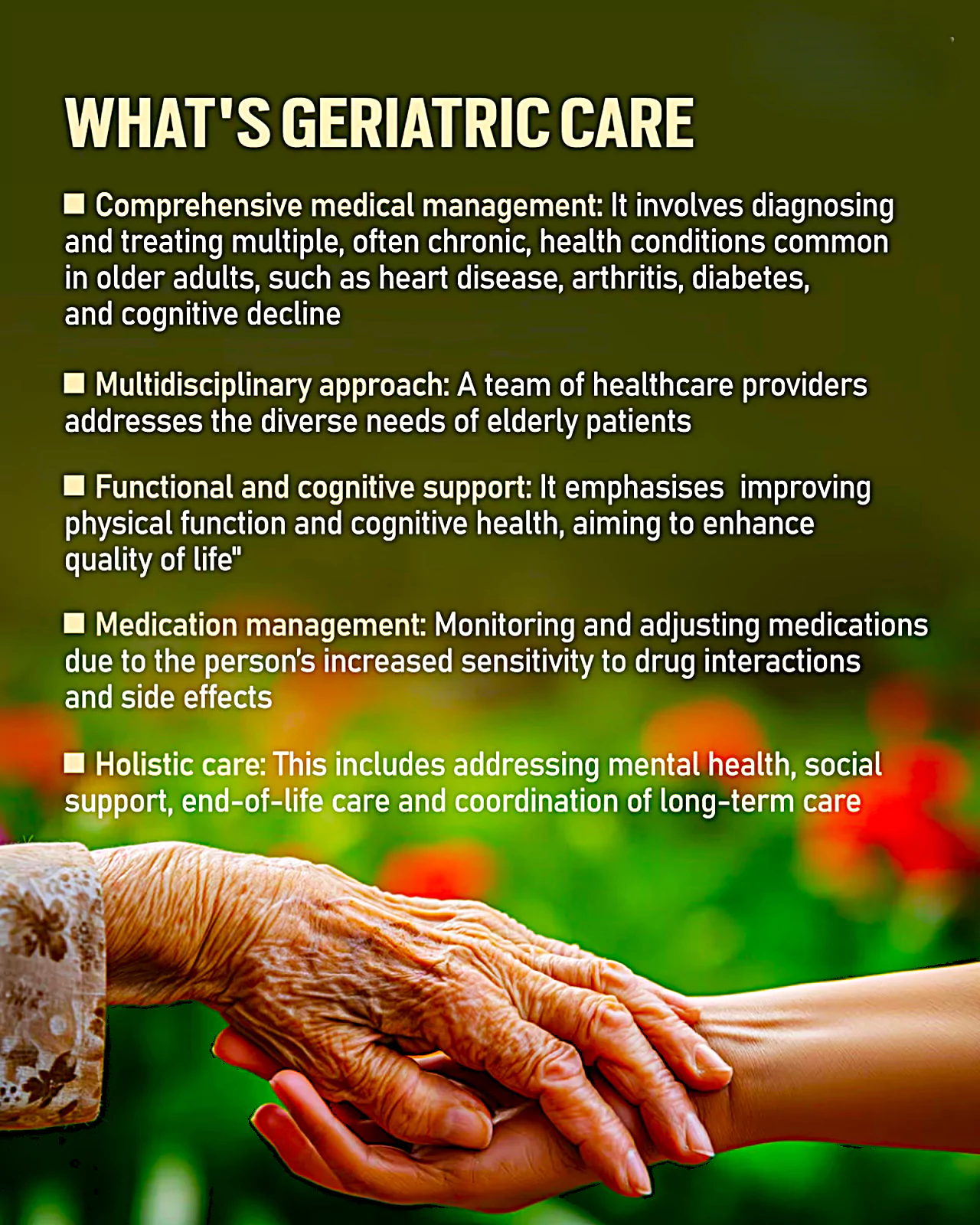With the country’s population continuing to age, there has been an exponential rise in the demand for geriatric care services.
| Geriatric care refers to the specialised medical and non-medical care provided to meet the health, functional, psychological, and social needs of older adults, typically those aged 60 years and above. |
Who is elderly?
- National Policy on Older Persons, 1999, and the National Policy for Senior Citizens, 2011, designate persons aged 60 years and above as elderly, focusing on their welfare, healthcare, financial security, and social inclusion.
Status of the Elderly Population in India (NITI Aayog Report, 2024)
- 12% of the total population consists of elderly people and is projected to reach 319 million by 2050, growing at a rate of around 3% per year.
| The number of people aged 65 and older is projected to rise from approximately 761 million in 2021 to 1.6 billion by 2050, according to the UN. |
- The overall sex ratio in the elderly population is 1065.
- 58% of the total number elderly are women, out of which 54% are widows
- The overall dependency ratio is 62 per 100 working-age population
- 7 out of 10 elderly persons reside in rural areas.
Demographic Shift and Rising Demand for Geriatric Care

- Rapid Growth of Elderly Population: India’s elderly (60+ years) stood at 149 million in 2022 and is projected to reach 319 million by 2050, comprising ~20% of the total population.
- Increasing Life Expectancy & Declining Fertility: Life expectancy has risen from 35.8 years (1950) to 75 years (projected for 2050), while fertility dropped from 5.9 (1950) to ~2.0 currently.
- A shrinking youth base and growing elderly dependency ratio (projected to be 61.2 by 2050).
- High Disease Burden Among Elderly: 75% of the elderly suffer from at least one chronic disease, and 23.3% experience multi-morbidity.
- Degenerative diseases like dementia, Alzheimer’s, and cardiovascular illnesses are on the rise, requiring specialized long-term care.
- Insufficient Geriatric Infrastructure and Workforce: Despite rising demand, geriatric care remains urban-centric and fragmented.
- National Centre for Ageing (Chennai) handles 800–1000 patients/day, highlighting huge unmet demand.
- India lacks adequate geriatricians and trained nurses to meet this growing need.
- Changing Family Structures Undermine Informal Elderly Support: Rising trend of nuclear families and youth migration leaves elderly isolated, often without caregivers.
- Tamil Nadu helplines report growing incidents of elderly abandonment, with many left in hospitals or public spaces.
Why the Elderly Population Is Skewed Towards Women?
According to Longitudinal Ageing Study of India (LASI) data, 58% of the elderly population in India are women, and a large proportion are widows.
- Higher Life Expectancy Among Women: Women tend to live longer than men due to biological advantages and lower risk-taking behaviors.
- Social Norms and Gendered Lifespans: Men often experience lifestyle-related illnesses (e.g., cardiovascular disease) earlier due to stress, alcohol, tobacco use—contributing to lower male life expectancy.
- Demographic Transition Patterns: Global and Indian trends show that as fertility declines and longevity improves, women tend to form a greater share of the very old (75+) population.
|
Challenges Faced by the Elderly in India
| As per the Census 2011, while the sex ratio at birth 940:1000 is skewed towards boys; for the elderly population (60+), it is reversed to 1033:1000 and projected to increase to 1060:1000 by 2026. |
- Health-Related Challenges
- Rising Burden of Diseases: 75% of elderly suffer from one or more chronic diseases, and 23.3% suffer from multi-morbidity (multiple co-existing conditions).
- Common illnesses: Diabetes, hypertension, arthritis, dementia, cancer.
- Limited Access to Healthcare: Only 18% of the elderly have health insurance; majority incur high out-of-pocket expenses (OOPE).
- Geriatric care is largely confined to urban tertiary centers; rural access remains weak.
- Limited Trained Workforce: Shortage of geriatricians, geriatric-trained nurses, and physiotherapists.
- Social Challenges
- Isolation and Abandonment: Rise of nuclear families and youth migration has left many elderly without caregivers.
- Elder Abuse: At least 5% of elderly have experienced physical, emotional, or financial abuse.
- Poor Awareness of Rights and Schemes: Only 12% aware of the Maintenance and Welfare of Parents and Senior Citizens Act (2007).
- 28% aware of any senior citizen concession.
- Economic Challenges
- Lack of Financial Security: 78% of elderly have no pension coverage.
- Many continue unpaid work, especially in agriculture—65% of elderly in rural areas still work post-retirement.
- High Healthcare Costs: Mean OOPE for inpatient care: ₹31,933—major reason for indebtedness (26% in urban India).
- Infrastructure and Service Gaps
- Lack of age-friendly infrastructure in public spaces (e.g., ramps, handrails, accessible transport).
- Infrastructure Deficits: Scarcity of:
- Age-friendly hospitals (with fall-safe design)
- Geriatric wards and day-care centres
- Assisted living and long-term care facilities.
- Neglected Preventive Care and Nutrition
- Adult vaccination (e.g., pneumococcal, flu) is not mainstreamed; every 2nd person over 60 has co-morbidities that increase risks.
- Nutritional issues:
- 27% underweight, 22% overweight.
- 4.7% anemic; increasing food insecurity in rural elderly.
Evolution of Geriatric Care in India
- Late 1970s: Dr. V.S. Natarajan establishes India’s first geriatric outpatient unit at Government General Hospital, Chennai.
- 1996: Dr. Natarajan launches first MD in Geriatrics at Madras Medical College with two seats, marking the start of specialized medical education in elder care.
- 1999: The National Policy on Older Persons first recognizes ageing as a distinct healthcare need.
- 2007: Maintenance and Welfare of Parents Act passed, providing legal protection against abandonment of elderly.
- 2010: National Programme for Health Care of the Elderly (NPHCE) launched to provide specialized healthcare to the elderly.
Impacts of Aging Population in India
- Healthcare System Strain: Increased demand for healthcare services, particularly geriatric and long-term care.
- Nearly 75% of the elderly have chronic diseases, and 23.3% face multi-morbidity.
- Pressure on Families and Caregivers: Rise in nuclear families and migration of youth has left many elderly isolated or abandoned.
- Emotional and financial burden increases on spouses or elderly caregivers.
- Economic Burden: Elderly incur higher OOPE (e.g., ₹31,933 for inpatient care).
- 78% of elderly lack pension; many continue working in low-paid/unpaid sectors.
- Higher consumption of healthcare, assisted living, and support services may increase public and private spending.
- Shrinking Workforce and Productivity: A rising elderly population and declining fertility rate (TFR ~2.0) leads to a higher dependency ratio. Projected to reach 61.2 by 2050.
- Reduction in working-age population affects economic productivity and tax base.
- Need for Age-Friendly Infrastructure: Majority of public spaces and transport are not elder-friendly: lack of ramps, handrails, benches, or accessible toilets.
- Rising demand for safe housing, assisted living, and senior activity centres.
- Increased Vulnerability: Elderly are more prone to climate change impacts, e.g., 31,000 heat-related deaths among 65+ in 2018.
- Also vulnerable to abuse, fraud, and neglect, particularly elderly women in rural areas.
Government Initiatives
- National Policy on Older Persons (NPOP), 1999:
- Objective: To ensure the well-being, dignity, and financial security of senior citizens.
- National Programme for Health Care of the Elderly (NPHCE), 2010:
- Objective: To provide accessible, affordable, and specialized healthcare for the elderly through the public health system.
- Ayushman Bharat – Pradhan Mantri Jan Arogya Yojana (PM-JAY), 2018:
- Objective: To provide universal health coverage, including for the elderly.
- In 2024, expanded to all senior citizens aged 70 and above.
- Offers up to ₹5 lakh per family annually for secondary and tertiary hospitalization, covering many elderly-specific conditions (e.g., cataract surgery, joint replacements).
Silver Economy
- The silver economy refers to the economic opportunities arising from the public and consumer expenditure related to elderly citizens.
- It includes the products and services they purchase directly and the indirect economic activities they stimulate.
|
- Maintenance and Welfare of Parents and Senior Citizens Act, 2007 (amended 2019):
- Objective: To ensure financial and emotional support for the elderly from their families.
- Mandates children or legal heirs to provide maintenance (up to ₹10,000/month) for parents/senior citizens.
- Rashtriya Vayoshri Yojana, 2017:
- Objective: To provide assistive devices to elderly from Below Poverty Line (BPL) families.
- Atal Vayo Abhyuday Yojana (AVYAY), 2021:
- Objective: To consolidate and expand elderly welfare schemes.
- Social Security Schemes:
- Indira Gandhi National Old Age Pension Scheme (IGNOAPS): Part of the National Social Assistance Programme (NSAP) in 2007 by the Ministry of Rural Development.
- Provides monthly pensions (₹200–₹500 by central government, supplemented by states) to BPL elderly aged 60+.
- Annapurna Scheme: Offers 10 kg of free food grains monthly to destitute elderly not covered by IGNOAPS.
- Pradhan Mantri Vaya Vandana Yojana (PMVVY): A pension scheme offering guaranteed returns for senior citizens investing a lump sum.
- Elderline (14567): National Helpline for Senior Citizens to address the grievance of the elders.
Way Forward for Elderly Care in India
- Strengthen Geriatric Healthcare: Integrate geriatric care into all levels of the healthcare system, Operationalise adult immunisation (e.g., pneumococcal, flu vaccines).
- Include Ayush systems in preventive and therapeutic care.
- Build Skilled Workforce: Establish geriatric medicine departments in all medical colleges.
- Train geriatric nurses, physiotherapists, and primary care physicians through short-term courses.
- Scale up state-level initiatives like Tamil Nadu’s elderly caregiver training program.
- Develop Age-Friendly Infrastructure: Ensure safe, accessible public spaces with ramps, elevators, handrails, and toilets.
- Encourage development of affordable and regulated assisted living and senior housing.
- Enhance Financial Security: Expand pension coverage and ensure timely disbursal under IGNOAPS and PMVVY.
- Promote reverse mortgage, elderly-friendly tax rebates, and affordable insurance products.
- Recognise and monetise unpaid contributions of elderly in care and volunteer roles.
- Focus on Mental Health and Social Inclusion: Integrate mental health services into primary care, especially in rural areas.
- Promote intergenerational bonding through school-level sensitisation campaigns.
- Establish Senior Activity Centres (SACs) and peer support groups for community engagement.
- Bridge the Digital Divide: Improve access to affordable digital devices for seniors.
- Conduct digital literacy programs to help elderly access health, banking, and government services.
- According to a survey conducted by the National Sample Survey Organization (NSSO), only 13 % of people aged 60 years or older have ever used the internet.
- Strengthen Legal and Policy Implementation: Speed up tribunal cases under the Maintenance and Welfare of Parents and Senior Citizens Act (2007).
- Launch a one-stop portal for all elderly-related schemes, services, and support.
- Promote Innovation and Private Sector Involvement: Encourage CSR participation in building elder homes, digital platforms, and care infrastructure.
- Support startups and innovations in elder tech, telemedicine, and geriatric aids.
- Develop the Silver Economy, projected to grow from $7B to $21B by 2027.
Conclusion
India’s aging population demands a robust, inclusive eldercare system integrating healthcare, social security, and technology. Strengthening policies, bridging rural-urban gaps, and fostering public-private partnerships are critical to ensuring dignity and well-being for the elderly by 2050.
![]() 17 Apr 2025
17 Apr 2025


